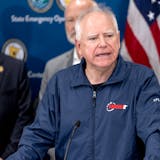ORTONVILLE, MINN. — For decades, Democrats dominated in places like this small town on Minnesota's western edge, where miles of flat farmland give way to the shores of Big Stone Lake and the storefronts that line its historic main street.
The mostly Scandinavian farmers who settled in the west-central region of the state flocked to the populist movements in the early part of the 20th century that eventually merged to create Minnesota's modern day Democratic-Farmer-Labor Party.
It's now been a decade since voters here elected a Democrat to represent them in the state Legislature. In 2020, residents in western Minnesota decisively ousted Collin Peterson, one of the last rural Democrats left standing in Congress.
"My grandparents were strong Democrats, this was a Democratic area and I think just over time the tides have really turned," said Kari Dorry, a teacher from Ortonville who is trying to stem the party's losses in her run for a rural state Senate seat. "It is kind of daunting, but I also think it's really motivating. We've got to try."
It's a familiar storyline playing out across rural Minnesota and the nation. Areas once amenable to a Democrat with the right message are now shutting out some of those same candidates, exacerbating geographic political divides and limiting places for the party to make inroads in the battle to control the Legislature and Congress.
Donald Trump accelerated the trend. The Republican flipped 19 counties in greater Minnesota in 2016 that had voted twice for Barack Obama. Despite Joe Biden's decisive 2020 victory in Minnesota, the Democrat flipped back just four counties outside of the metro.
Gregg Peppin, a GOP campaign strategist, said the voters in Trump's flipped counties "have made the switch" and will be hard to win back. "Democrats are being defined by their most progressive legislators and activists, and that sends a signal to rural voters that just don't fit into that party."
Looking ahead to the midterms, the DFL Party is pumping resources into organizing in small towns and cities, and leaders are scrambling to recruit candidates under new redistricting maps who might able to turn the tide in rural Minnesota.



